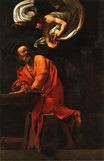Caravaggio - John the Baptist 1602
 |
 |
 |
 |
 |
 |
 |

John the Baptist 1602
129x94cm oil/canvas
Capitoline Museums, Rome, Italy
The image is only being used for informational and educational purposes
<< Previous G a l l e r y Next >>
From Wikipedia, the free encyclopedia:
The model for Amor Vincit was a boy named Cecco, Caravaggio's servant and possibly his pupil as well. He has been tentatively identified with an artist active in Rome about 1610-1625, otherwise known only as Cecco del Caravaggio – Caravaggio's Cecco – who painted very much in Caravaggio's style. The most striking feature of Amor was the young model's evident glee in posing for the painting, so that it became rather more a portrait of Cecco than a depiction of a Roman demi-god. The same sense of the real-life model overwhelming the supposed subject was transferred to Mattei's John the Baptist. The youthful John is shown half-reclining, one arm around a ram's neck, his turned to the viewer with an impish grin. There's almost nothing to signify that this indeed the prophet sent to make straight the road in the wilderness – no cross, no leather belt, just a scrap of camel's skin lost in the voluminous folds of the red cloak, and the ram. The ram itself is highly un-canonical – John the Baptist's animal is supposed to be a lamb, marking his greeting of Christ as the 'Lamb of God' come to take away the sins of mankind. The ram is as often a symbol of lust as of sacrifice, and this naked smirking boy conveys no sense of sin whatsoever. Some biographers have tried to depict Caravaggio as an essentially orthodox Catholic of the Counter-Reformation, but Cecco the Baptist seems as irredeemably pagan as his previous incarnation as Cupid.